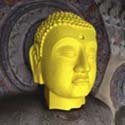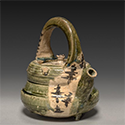|
|
| Show All 80 Results (Text Only) |
|
| Buddhist Cave Temple Sculpture |
|
| Victoria and Albert Museum
|
The Central Asian tradition of building such complexes was been practiced for centuries, primarily with Imperial sponsorship in the Northern regions, where Buddhism first took hold. The very act of creating these vast monuments, hollowed out from rock faces and decorated so lavishly within, was considered an act of 'piety' resulting in the accrual of merit, which in Buddhism is accumulated as a result of good deeds, acts or thoughts. This merit is then carried over to later in life or to a person's next birth. The sculptures and paintings also functioned as an important focus for worship and as symbolic links between the worldly and heavenly realms. People would have travelled great distances to see them and to worship and make offerings before them.
Go to Museum Resource: http://www.vam.ac.uk/content/articles/c/chinese-buddhist-cave-temple-sculpture/ | |
|
|
| The Buddhist Cave Temples of Xiangtangshan |
|
| New York University, Institute for the Study of the Ancient World
|
Carved into the side of a mountain, the Buddhist cave temples at Xiangtangshan (“Shahng-tahng-shahn”) are the crowning cultural achievement of the short-lived Northern Qi (“Chee”) dynasty, which ruled over most of northeastern China from 550 to 577 ce. The name Xiangtangshan translates as “Mountain of Echoing Halls,” and refers to two groups of rock-cut shrines in Hebei province close to ancient Ye, the Northern Qi capital. The emperors and courtiers who commissioned the temples were non-Chinese, of mixed ethnicities from north of the Great Wall, and practiced Buddhism, a religion favored by this elite. In their entirety, these cave temples housed an awe-inspiring world below ground and reflect a long tradition, begun in India, of situating holy places within the earth itself. Includes 12 over life-size sculptures from this Buddhist cave temple complex with a full-scale, digital, 3-D reconstruction of the interior of one of the site’s impressive caves.
Go to Museum Resource: http://isaw.nyu.edu/exhibitions/echoes | |
|
|
|
| Buddhist Sculpture from China |
|
| China Institute
|
“The period covered by Buddhist Sculpture from China fits within Era 4 of the National History Standards, “Expanding Zones of Exchange and Encounter, 300-1000 CE”: Buddhist, Christian, and Hindu Traditions: Not only Islam but other major religions also spread widely during this 700-year era. Wherever these faiths were introduced, they carried with them a variety of cultural traditions, aesthetic ideas, and ways of organizing human endeavor. Each of them also embraced peoples of all classes and diverse languages in common worship and moral commitment….The entry of Buddhism into China and East Asia at the beginning of the Common Era is central to any perception of cultural exchange as playing “a crucial role in human history, being perhaps the most important external stimuli to change, leaving aside military conquest” (Curtin 1984: 1).”
Go to Museum Resource: https://china360online.org/?property=buddhist-sculpture-from-china | |
|
|
| Chado: The Japanese Tea Ceremony |
|
| The Cleveland Museum of Art
|
This lesson introduces students to the Japanese tea ceremony to consider the art and the tradition of the tea ceremony and study the serving pieces used in the ceremony by participating in a tea ceremony. Students will learn the importance of the performance of tea ceremony through the history of how it became what it is today.
Go to Museum Resource: http://www.clevelandart.org/lesson-plan-packet/chado-japanese-tea-ceremony | |
|
|
|
| Confucianism, Daoism, Buddhism: How do different belief systems fit together in one country? [PDF] |
|
| The Field Museum
|
In this lesson plan students will explore three major belief systems in China–Buddhism, Confucianism, and Daoism - through art and artifacts. Through discussion and object-study, students will wrestle with how these different belief systems co-existed in China, and how they influenced and Informed each other. Spanish PDF also available.
Go to Museum Resource: https://www.fieldmuseum.org/sites/default/files/lifeways.pdf | |
|
|
| Confucius, Shotoku, and the Golden Rule |
|
| The Cleveland Museum of Art
|
Confucian thought, Prince Shotoku’s Constitution, and the Golden Rule provide an opportunity for teachers and students to develop a shared vision for learning and classroom relationships. By looking at these ancient sayings, modern-day students can formulate their own rules of conduct.
Go to Museum Resource: http://www.clevelandart.org/lesson-plan-packet/confucius-shotoku-and-golden-rule | |
|
|
|
| Show All 80 Results (Text Only) |








